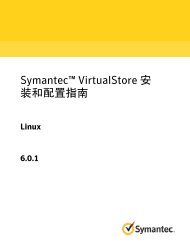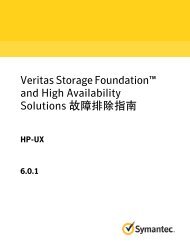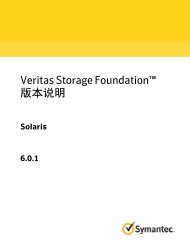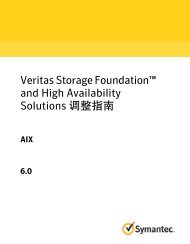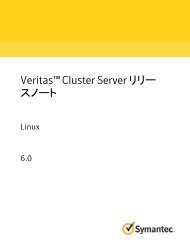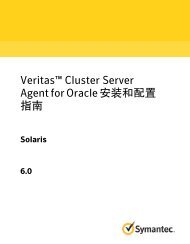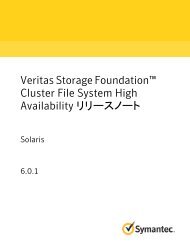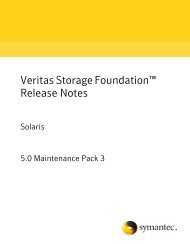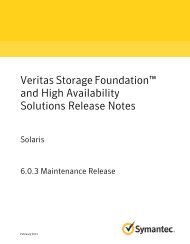Veritas Cluster Server Release Notes
Veritas⢠Cluster Server Release Notes: Linux - SORT - Symantec
Veritas⢠Cluster Server Release Notes: Linux - SORT - Symantec
- No tags were found...
You also want an ePaper? Increase the reach of your titles
YUMPU automatically turns print PDFs into web optimized ePapers that Google loves.
<strong>Veritas</strong> <strong>Cluster</strong> <strong>Server</strong> <strong>Release</strong> <strong>Notes</strong><br />
Software limitations<br />
84<br />
recommended to use <strong>Veritas</strong> Operations Manager (VOM) since all new features<br />
are already supported in VOM. However, Java console may continue to work as<br />
expected with features of releases prior to VCS 6.0.<br />
Port change required to connect to secure cluster [2615068]<br />
In order to connect to secure cluster, the default port must be changed from 2821<br />
to 14149. You must choose Advanced settings in the Login dialog box and change<br />
IP: 2821 to IP: 14149 for secure cluster login.<br />
Limitations related to I/O fencing<br />
This section covers I/O fencing-related software limitations.<br />
Preferred fencing limitation when VxFEN activates RACER node<br />
re-election<br />
The preferred fencing feature gives preference to more weighted or larger<br />
subclusters by delaying the smaller subcluster. This smaller subcluster delay is<br />
effective only if the initial RACER node in the larger subcluster is able to complete<br />
the race. If due to some reason the initial RACER node is not able to complete the<br />
race and the VxFEN driver activates the racer re-election algorithm, then the smaller<br />
subcluster delay is offset by the time taken for the racer re-election and the less<br />
weighted or smaller subcluster could win the race. This limitation though not<br />
desirable can be tolerated.<br />
Stopping systems in clusters with I/O fencing configured<br />
The I/O fencing feature protects against data corruption resulting from a failed<br />
cluster interconnect, or “split brain.” See the <strong>Veritas</strong> <strong>Cluster</strong> <strong>Server</strong> Administrator's<br />
Guide for a description of the problems a failed interconnect can create and the<br />
protection I/O fencing provides.<br />
In a cluster using SCSI-3 based fencing, I/O fencing implements data protection<br />
by placing the SCSI-3 PR keys on both the data disks and coordinator disks. In a<br />
cluster using CP server-based fencing, I/O fencing implements data protection by<br />
placing the SCSI-3 PR keys on data disks and similar registrations on CP server.<br />
The VCS administrator must be aware of several operational changes needed when<br />
working with clusters protected by I/O fencing. Specific shutdown procedures ensure<br />
keys are removed from coordination points and data disks to prevent possible<br />
difficulties with subsequent cluster startup.<br />
Using the reboot command rather than the shutdown command bypasses shutdown<br />
scripts and can leave keys on the coordination points and data disks. Depending



